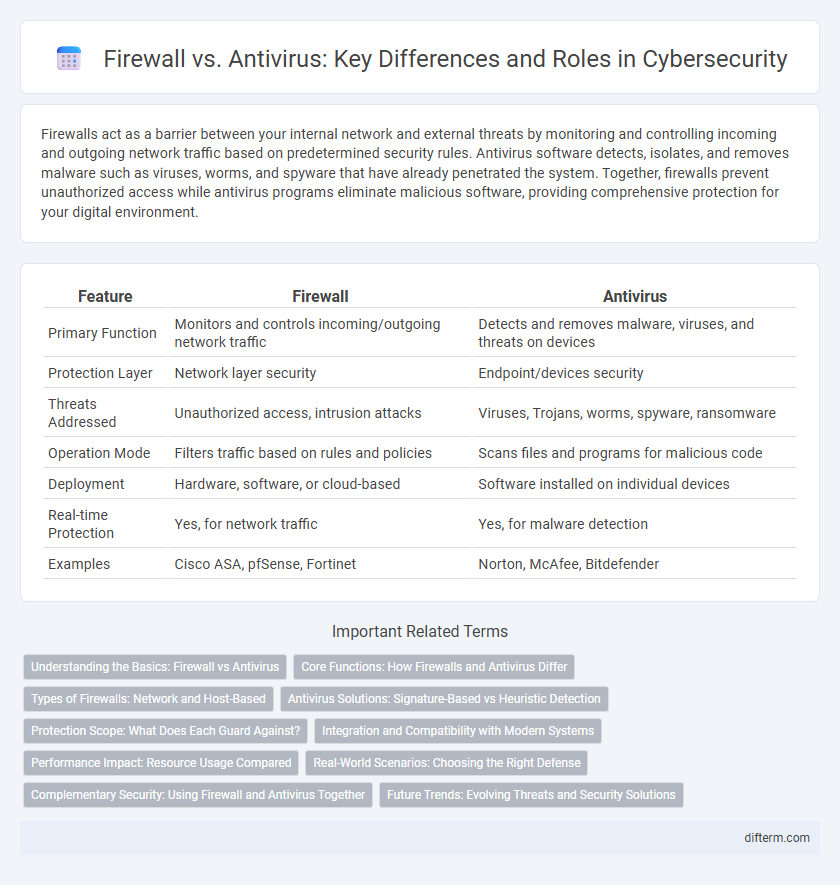Firewalls act as a barrier between your internal network and external threats by monitoring and controlling incoming and outgoing network traffic based on predetermined security rules. Antivirus software detects, isolates, and removes malware such as viruses, worms, and spyware that have already penetrated the system. Together, firewalls prevent unauthorized access while antivirus programs eliminate malicious software, providing comprehensive protection for your digital environment.
Table of Comparison
| Feature | Firewall | Antivirus |
|---|---|---|
| Primary Function | Monitors and controls incoming/outgoing network traffic | Detects and removes malware, viruses, and threats on devices |
| Protection Layer | Network layer security | Endpoint/devices security |
| Threats Addressed | Unauthorized access, intrusion attacks | Viruses, Trojans, worms, spyware, ransomware |
| Operation Mode | Filters traffic based on rules and policies | Scans files and programs for malicious code |
| Deployment | Hardware, software, or cloud-based | Software installed on individual devices |
| Real-time Protection | Yes, for network traffic | Yes, for malware detection |
| Examples | Cisco ASA, pfSense, Fortinet | Norton, McAfee, Bitdefender |
Understanding the Basics: Firewall vs Antivirus
Firewalls serve as a barrier between trusted internal networks and untrusted external networks, filtering incoming and outgoing traffic based on predefined security rules. Antivirus software detects, quarantines, and removes malware such as viruses, worms, and trojans from individual devices. Understanding the distinction helps organizations implement comprehensive security by combining firewall network protection with antivirus endpoint defense.
Core Functions: How Firewalls and Antivirus Differ
Firewalls primarily control incoming and outgoing network traffic by establishing a barrier between trusted internal networks and untrusted external ones to prevent unauthorized access. Antivirus software specializes in detecting, quarantining, and removing malicious software such as viruses, worms, and Trojans within a device. While firewalls regulate data flow based on predefined security rules, antivirus solutions focus on scanning and eliminating malware to protect system integrity.
Types of Firewalls: Network and Host-Based
Network firewalls protect entire networks by filtering traffic between external sources and internal systems, employing packet filtering, stateful inspection, or proxy services to monitor data flows. Host-based firewalls run on individual devices, controlling inbound and outbound traffic specifically for that host and providing granular security tailored to user or application needs. Both types complement antivirus software but focus primarily on preventing unauthorized access rather than detecting and removing malware.
Antivirus Solutions: Signature-Based vs Heuristic Detection
Antivirus solutions utilize signature-based detection to identify known malware by matching files against a database of virus signatures, providing precise and quick threat identification. Heuristic detection complements this by analyzing the behavior and characteristics of programs to detect previously unknown or modified malware, enhancing protection against zero-day threats. Combining both methods delivers a robust defense, balancing accuracy with proactive threat detection to safeguard systems effectively.
Protection Scope: What Does Each Guard Against?
Firewalls primarily protect against unauthorized network access by filtering incoming and outgoing traffic based on predefined security rules, effectively blocking hacking attempts and network-based threats. Antivirus software targets malware, such as viruses, trojans, ransomware, and spyware, by scanning, detecting, and removing malicious code embedded in files or programs. While firewalls serve as a barrier controlling traffic flow to prevent intrusions, antivirus solutions focus on identifying and eliminating harmful software already present on a device.
Integration and Compatibility with Modern Systems
Firewalls and antivirus software both play crucial roles in cybersecurity, with firewalls controlling network traffic and antivirus programs detecting and removing malware. Modern firewalls integrate seamlessly with operating systems such as Windows 11, macOS Ventura, and popular Linux distributions, offering advanced features like deep packet inspection and VPN support. Antivirus solutions optimize compatibility with cloud environments and endpoint devices, ensuring real-time protection across diverse systems while minimizing performance impact.
Performance Impact: Resource Usage Compared
Firewalls primarily monitor and control incoming and outgoing network traffic, using fewer system resources compared to antivirus software, which continuously scans files and programs for malware signatures and suspicious behavior. Antivirus solutions tend to consume more CPU and memory during active scans or real-time protection, potentially slowing down system performance. Effective security setups balance firewall efficiency with antivirus thoroughness to optimize resource usage and maintain system responsiveness.
Real-World Scenarios: Choosing the Right Defense
In real-world scenarios, firewalls act as gatekeepers by monitoring and controlling incoming and outgoing network traffic based on predetermined security rules, effectively preventing unauthorized access to a system or network. Antivirus software specializes in detecting, quarantining, and removing malware such as viruses, trojans, and worms that have already infiltrated a device. Selecting the right defense involves assessing whether threats primarily originate from network breaches or malware infections, with many organizations benefiting from an integrated approach that combines firewall protection and antivirus solutions for comprehensive security coverage.
Complementary Security: Using Firewall and Antivirus Together
Firewalls and antivirus software provide complementary layers of security by addressing different threats: firewalls control incoming and outgoing network traffic to block unauthorized access, while antivirus programs detect and remove malware from devices. Combining firewall protection with antivirus scanning enhances overall cybersecurity by preventing external attacks and identifying malicious software before it can cause harm. This integrated approach reduces vulnerabilities and reinforces defense mechanisms against a broad range of cyber threats.
Future Trends: Evolving Threats and Security Solutions
Future trends in cybersecurity highlight the integration of AI-driven firewalls capable of detecting and responding to sophisticated zero-day exploits in real time, surpassing traditional antivirus capabilities focused on signature-based malware detection. Next-generation firewalls incorporate machine learning algorithms to analyze network behavior patterns and block emerging threats before they infiltrate systems, while antivirus software evolves to include heuristic analysis and cloud-based threat intelligence sharing. As cyber threats become increasingly complex and polymorphic, the convergence of firewall and antivirus technologies will emphasize proactive threat prevention, automated response mechanisms, and adaptive security frameworks to safeguard dynamic digital environments.
Firewall vs Antivirus Infographic

 difterm.com
difterm.com